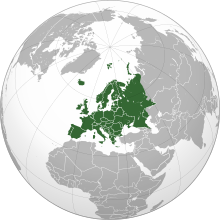Eropah
Eropah (jaku Gerika: Ευρώπη/Evropi) ianya siti benua ti bepalan ba Tasik Atlantik ba barat, Tasik Artik ba utara, Bukit-bukit Ural enggau Sungai Ural ba timur, Tasik Kaspia, Bukit Caucasus enggau Tasik Chelum ba Tenggara, enggau Tasik Mediterranean ba selatan.
| Area | 10,180,000 km2 (3,930,000 bt2)[1] (6th)[a] |
|---|---|
| Population | 745,173,774 (2021; 3rd)[2][3] |
| Population density | 72.9/km2 (188/sq mi) (2nd) |
| GDP (PPP) | $33.62 trillion (2022 est; 2nd)[4] |
| GDP (nominal) | $24.02 trillion (2022 est; 3rd)[5] |
| GDP per capita | $34,230 (2022 est; 3rd)[c][6] |
| HDI | |
| Religions | |
| Countries | Sovereign (44–50) De facto (2–5) |
| Dependencies | External (5–6) Internal (3) |
| Languages | Most common: |
| Time zones | UTC−1 to UTC+5 |
| Largest cities | Largest urban areas: |
| UN M49 code | 150 – Europe001 – World |
| |
Eropah ngembuan pemesai 10.18 juta km2 (3.93 juta batu persegi) tauka 2% ari serata bumi (6.8% ari pemesai tanah), nyadi ka benua nya benua kedua pemadu mit (ngena model tujuh benua). Nitihka politik, Eropah ulih dibagi ngagai dalam lima puluh menua, ia nya Rusia ti nyadi menua ti pemadu besai enggau ngembuan orang ti pemadu mayuh, ngambi 39% pemesai benua nya enggau 15% ari penyampau orang ba Eropah. Eropah ngembuan penyampau 745 juta orang (dalam 10% ari penyampau orang ba dunya) maya taun 2021.[10][11]
Penerang
edit- ↑ "Largest Countries In Europe 2020". worldpopulationreview.com. Archived from the original on 8 July 2022. Retrieved 30 July 2022.
- ↑ "World Population Prospects 2022". United Nations Department of Economic and Social Affairs, Population Division. Retrieved July 17, 2022.
- ↑ "World Population Prospects 2022: Demographic indicators by region, subregion and country, annually for 1950-2100" (XSLX) ("Total Population, as of 1 July (thousands)"). United Nations Department of Economic and Social Affairs, Population Division. Retrieved July 17, 2022.
- ↑ "GDP PPP, current prices". International Monetary Fund. 2022. Archived from the original on 22 January 2021. Retrieved 16 January 2022.
- ↑ "GDP Nominal, current prices". International Monetary Fund. 2022. Archived from the original on 25 February 2017. Retrieved 16 January 2022.
- ↑ "Nominal GDP per capita". International Monetary Fund. 2022. Archived from the original on 11 January 2020. Retrieved 16 January 2022.
- ↑ "Reports". Human Development Reports. Archived from the original on 9 July 2012. Retrieved 21 July 2017.
- ↑ 8.0 8.1 8.2 8.3 Penyalat nyebut: Tag
<ref>tidak sah; tiada teks disediakan bagi rujukan yang bernamaSurvey - ↑ "Demographia World Urban Areas" (PDF). Demographia. Archived (PDF) from the original on 3 May 2018. Retrieved 28 October 2020.
- ↑ World Population Prospect 2022: Demographics indicators by region, subregion and country, annually for 1950-2100 (XSLX). population.un.org ("Total Population, as of 1 July (thousands)"). United Nations Department of Economic and Social Affairs, Population Division. Diambi maya 24 September 2022
- ↑ "World Population Prospects 2022" population.un.org. United Nations Department of Economic and Social Affairs, Population Division. Diambi 24 September 2022.

